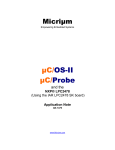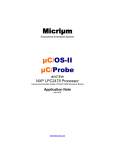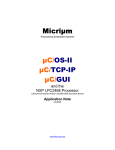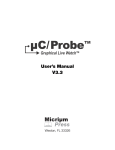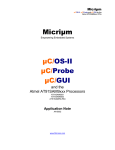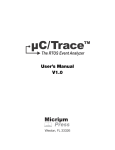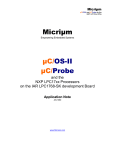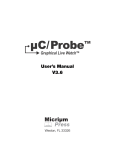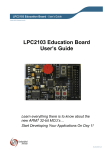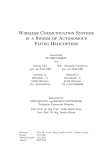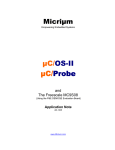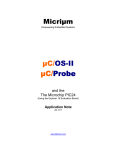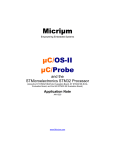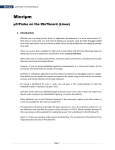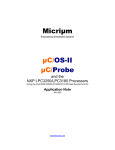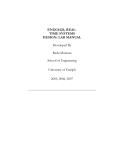Download OSs-Micrium-Learning Centre-Application Notes
Transcript
Micriµm
Empowering Embedded Systems
µC/OS-II
µC/Probe
and the
NXP LPC2103
(Using the IAR LPC2103-02-SK Kickstart Kit)
Application Note
AN-1074
www.Micrium.com
Micriµm
µC/OS-II and µC/Probe for the
NXP LPC2103 CPU
About Micriµm
Micriµm provides high-quality embedded software components in the industry by way of engineer-friendly
source code, unsurpassed documentation, and customer support. The company‟s world-renowned realtime operating system, the Micriµm µC/OS-II, features the highest-quality source code available for
today's embedded market. Micriµm delivers to the embedded marketplace a full portfolio of embedded
software components that complement µC/OS-II. A TCP/IP stack, USB stack, CAN stack, File System
(FS), Graphical User Interface (GUI), as well as many other high quality embedded components.
Micriµm‟s products consistently shorten time-to-market throughout all product development cycles. For
additional information on Micriµm, please visit www.micrium.com.
About µC/OS-II
µC/OS-II is a preemptive, real-time, multitasking kernel. µC/OS-II has been ported to over 45 different
CPU architectures.
µC/OS-II is small yet provides all the services you‟d expect from an RTOS: task management, time and
timer management, semaphore and mutex, message mailboxes and queues, event flags an much more.
You will find that µC/OS-II delivers on all your expectations and you will be pleased by its ease of use.
Licensing
µC/OS-II is provided in source form for FREE evaluation, for educational use or for peaceful research. If
you plan on using µC/OS-II in a commercial product you need to contact Micriµm to properly license its
use in your product. We provide ALL the source code with this application note for your convenience and
to help you experience µC/OS-II. The fact that the source is provided DOES NOT mean that you can
use it without paying a licensing fee. Please help us continue to provide the Embedded community with
the finest software available. Your honesty is greatly appreciated.
2
Micriµm
µC/OS-II and µC/Probe for the
NXP LPC2103 CPU
About µC/Probe Demo Version
μC/Probe is a Windows application that allows a user to display and change the value (at run-time) of
virtually any variable or memory location on a connected embedded target. The user simply populates
μC/Probe‟s graphical environment with gauges, tables, graphs, and other components, and associates
each of these with a variable or memory location. Once the application is loaded onto the target, the user
can begin μC/Probe‟s data collection, which will update the screen with variable values fetched from the
target.
μC/Probe retrieves the values of global variables from a connected embedded target and displays the
values in an engineer-friendly format. The supported data-types are: booleans, integers, floats and ASCII
strings.
μC/Probe can have any number of „data screens‟ where these variables are displayed. This allows to
logically grouping different „views‟ into a product.
This μC/Probe demo version can only retrieve information from RS-232C or J-LINK interfaces and is
limited up to 15 symbols.
The demo version of μC/Probe is available on the Micriµm website:
http://www.micrium.com/products/probe/probe.html
About µC/Probe Full Version
The full version of μC/Probe allows you to use a TCP/IP is a Windows application that allows a user to
display and change the value (at run-time) of virtually any variable or memory location on a connected
embedded target. The user simply populates μC/Probe‟s graphical environment with gauges, tables,
graphs, and other components, and associates each of these with a variable or memory location. Once
the application is loaded onto the target, the user can begin μC/Probe‟s data collection, which will update
the screen with variable values fetched from the target.
3
Micriµm
µC/OS-II and µC/Probe for the
NXP LPC2103 CPU
Manual Version
If you find any errors in this document, please inform us and we will make the appropriate corrections for
future releases.
Version
Date
By
Description
V 1.00
2008/19/19
FT
Initial revision.
Software Versions
This document may or may not have been downloaded as part of an executable file, Micrium-NXP-uCOSII-LPC2103-02-SK.exe containing the code and projects described here. If so, then the versions of the
Micriµm software modules in the table below would be included. In either case, the software port
described in this document uses the module versions in the table below
Module
Version
μC/OS-II
V2.86
μC/Probe
V2.20
Comment
4
Micriµm
µC/OS-II and µC/Probe for the
NXP LPC2103 CPU
Document Conventions
Numbers and Number Bases
Hexadecimal numbers are preceded by the “0x” prefix and displayed in a monospaced font.
Example: 0xFF886633.
Binary numbers are followed by the suffix “b”; for longer numbers, groups of four digits are
separated with a space. These are also displayed in a monospaced font. Example: 0101 1010
0011 1100b.
Other numbers in the document are decimal.
prevailing where the number is used.
These are displayed in the proportional font
Typographical Conventions
Hexadecimal and binary numbers are displayed in a monospaced font.
Code excerpts, variable names, and function names are displayed in a monospaced font.
Functions names are always followed by empty parentheses (e.g., OS_Start()). Array names
are always followed by empty square brackets (e.g., BSP_Vector_Array[]).
File and directory names are always displayed in an italicized serif font.
/Micrium/Sofware/uCOS-II/Source/.
Example:
A bold style may be layered on any of the preceding conventions—or in ordinary text—to more
strongly emphasize a particular detail.
Any other text is displayed in a sans-serif font.
5
Micriµm
µC/OS-II and µC/Probe for the
NXP LPC2103 CPU
Table of Contents
Table of Contents
6
1.
Introduction
7
2.
2.01
2.02
2.03
2.03.01
2.04
Getting Started
Setting up the Hardware
Directory Tree
Using the IAR Projects
µC/OS-II Kernel Awareness
Example Applications
9
9
9
11
11
12
3.
Directories and Files
13
4.
4.01
4.02
Application Code
app.c
os_cfg.h
16
16
18
5.
5.01
5.02
Board Support Package (BSP)
BSP, bsp.c and bsp.h
Processor Initialization Functions
19
19
20
6.
μC/Probe
22
Licensing
25
References
25
Contacts
25
6
Micriµm
µC/OS-II and µC/Probe for the
NXP LPC2103 CPU
1.
Introduction
This document, AN-1074, explains example code for using µC/OS-II and µC/Probe with the NXP
LPC2103 processor on the IAR LPC2103-02-SK evaluation board, shown in Figure 1.
The LPC2103 microcontroller is based on a 16-bit/32-bit ARM7TDMI-S CPU with real-time emulation that
combines the microcontroller with 32 kB of embedded high speed flash memory. A blend of serial
communications interfaces, ranging from multiple UARTS, SPI, and SSP to two I2Cs, and on-chip SRAM
of 8 kB make these devices very well suited for communication gateways and protocol converters.
The IAR LPC2103-02-SK board includes :
• NXP LPC2103 MCU
• J-LINK on-chip with USB cable
• One serial port
• Reset button
• In-system programming (ISP) button
• Two user-defined buttons
• 16 fully configurable LEDs
• Power-on LED
• Lithium back-up battery and holder
• Breakout headers for all pins (suitable for mounting daughter boards)
• Small array of plated holes for prototyping
LEDs
RS-232
(for µC/Probe)
Potentiometer
Push Buttons
J-LINK on-chip with
USB Cabe
Figure 1-1. IAR LCP2103-02-SK
7
Micriµm
µC/OS-II and µC/Probe for the
NXP LPC2103 CPU
If this appnote was downloaded in a packaged executable zip file, then it should have been found in the
directory /Micrium/Appnotes/AN1xxx-RTOS/AN1074-uCOS-II-NXP-LPC2103-02-SK and the code files
referred to herein are located in the directory structure displayed in Section 2.02; these files are described
in Section 3.
The executable zip also includes example workspaces for µC/Probe. µC/Probe is a Windows program
which retrieves the value of variables form a connected embedded target and displays the values in an
engineer-friendly format as shown in Figure 1-2. It interfaces with the IAR LPC2103-02-SK via RS-232C.
For more information, including instructions for downloading a trial and the demo version of the program,
please refer to Section 6.
Figure 1-2. µC/Probe (with Target Output Window)
8
Micriµm
µC/OS-II and µC/Probe for the
NXP LPC2103 CPU
2.
Getting Started
The following sections step through the prerequisites for using the demonstration application described in
this document, AN-1074 First, the setup of the hardware will be outlined. Second, the use and setup of
the IAR Embedded Workbench project will be described. Thirdly, the steps to build the projects and load
the application onto the board through a JTAG will be described. Lastly, instructions will be provided for
using the example application.
2.01
Setting up the Hardware
The evaluation board can only be powered through the USB connector on the board. The processor on
the evaluation board can be programmed and debugged through the USB J-LINK port.
To use µC/Probe with the IAR-LPC2103-02-SK, download and install the trial version of the program
from the Micriµm website as discussed in Section 6. After programming your target with one of the
included example projects, connect a RS-232 cable between your PC and the evaluation board, configure
the RS-232 options (also covered in Section 6), and start running the program. The open data screens
should update. The IAR LPC2103-02-SK example application is configured to use UART0, the RS-232C
connector labeled “RS-232 for µC/Probe” in Figure 1-1.
2.02
Directory Tree
If this file were downloaded as part of an executable zip file (which should have been named
Micrium-NXP-uCOS-II-LPC2103-02-SK.exe, then the code files referred to herein are located in the directory
structure shown in Figure 2-2.
9
Micriµm
µC/OS-II and µC/Probe for the
NXP LPC2103 CPU
Licensing agreements
(If µC/OS-II is used
commercially)
Contact
www.Micrium.com
for pricing
\Micrium
\AppNotes
AN-1018
\AN1xxx-RTOS
\AN1014-uCOS-II-ARM
\AN1074-uCOS-II-NXP-LPC2103-02-SK
\AN9xxx-MULT
\AN9913-IAR-Probe-Demo
AN-1074
AN-9913
\Licensing
\Software
\EvalBoards
\<NXP>
\LPC2103-02-SK
\IAR
\BSP
\OS-Probe
Board Support Package
(BSP)
IAR Example Project
\uC-CPU
\ARM
\IAR
\uC-LIB
µC/OS-II
The Real Time
Kernel
µC/OS-II
documentation
\uCOS-II
\Doc
\Ports
\ARM
ARM7 / ARM9
µC/OS-II port
\Generic
\IAR
\Source
µC/Probe
Real-Time Monitor
µC/OS-II processor
independent source
code
\uC-Probe
\Target
\Communication
\DCC
Target
\Generic
Communication
\OS
\uCOS-II
\RS-232
RS-232
\OS
Communication
\uCOS-II
\Ports
\NXP
µC/Probe
\LPC21xx
\Source
LPC21xx Port
\Source
\KSD
µC/Probe
\Source
IAR Kickstart Kits
\Workspace
Demo
\Plugins
AN-9913
\uCOS-II
Figure 2-1. Directory Structure
10
Micriµm
µC/OS-II and µC/Probe for the
NXP LPC2103 CPU
2.03
Using the IAR Projects
One IAR project is located in the directory marked “IAR Example Project ” in Figure 2-1:
/Micrium/Software/EvalBoards/NXP/LPC2103-02-SK/IAR/OS-Probe
The example project, LPC2103-02-SK-OS-Probe-v5-2.ewp, is intended for EWARM v5.2x. To view this
example, start an instance of IAR EWARM v5.2x, and open the workspace file
LPC2103-02-SK-OS-Probe-v5-2.eww. To do this, select the “Open” menu command under the “File” menu,
select the “Workspace…” submenu command and select the workspace file after navigating to the project
directory. The project tree shown in Figure 2-2 should appear. (In addition, the workspace should be
openable by double-clicking on the file itself in a Windows Explorer window.)
2.03.01
µC/OS-II Kernel Awareness
When running the IAR C-Spy debugger, the μC/OS-II Kernel Awareness Plug-In can be used to provide
useful information about the status of μC/OS-II objects and tasks. If the μC/OS-II Kernel Awareness
Plug-In is currently enabled, then a “μC/OS-II” menu should be displayed while debugging. Otherwise, the
plug-in can be enabled. Stop the debugger (if it is currently active) and select the “Options” menu item
from the “Project” menu. Select the “Debugger” entry in the list box and then select the “Plugins” tab
pane. Find the μC/OS-II entry in the list and select the check box beside the entry, as shown in
Figure 2-4.
When the code is reloaded onto the evaluation board, the “μC/OS-II” menu should appear. Options are
included to display lists of kernel objects such as semaphores, queues, and mailboxes, including for each
entry the state of the object. Additionally, a list of the current tasks may be displayed, including for each
task pertinent information such as used stack space, task status, and task priority, in addition to showing
the actively executing task. An example task list for this project is shown in Figure 2-5.
Figure 2-4. Enabling the μC/OS-II Kernel Awareness Plug-In
11
Micriµm
µC/OS-II and µC/Probe for the
NXP LPC2103 CPU
Figure 2-5. µC/OS-II Task List.
2.04
Example Applications
The example projects include a basic demonstration of the µC/OS-II and µC/Probe. After you load the
evaluation board the sample project, the LEDs will start blinkging
Stack Out of Range Notification
While debugging this project (or any other μC/OS-II project), IAR may log a SVC stack
pointer out-of-range notification in the “Debug Log” window. This is actually normal
behavior and does NOT indicate an error. IAR EWARM does not understand that the
SVC stack pointer points to the stack for the current task stack.
12
Micriµm
µC/OS-II and µC/Probe for the
NXP LPC2103 CPU
3.
Directories and Files
Application Notes
/Micrium/AppNotes/AN1xxx-RTOS\AN1014-uCOS-II-ARM
This directory contains AN-1014.pdf, the application note describing the ARM port for μC/OS-II,
and AN-1014-PPT.pdf, a supplement to AN-1014.pdf.
\Micrium\AppNotes\AN1xxx-RTOS\AN1074-uCOS-II-NXP-LPC2103-02-SK
This directory contains this application note, AN-1074pdf.
\Micrium\AppNotes\AN9xxx-MULT\AN-9913-IAR-Probe-Demo
This directory contains this application note, AN-9913.pdf.
Licensing Information
\Micrium\Licensing
Licensing agreements are located in this directory. Any source code accompanying this appnote
is provided for evaluation purposes only. If you choose to use μC/OS-II in a commercial product,
you must contact Micriμm regarding the necessary licensing.
μC/OS-II Files
\Micrium\Software\uCOS-II\Doc
This directory contains documentation for μC/OS-II.
\Micrium\Software\uCOS-II\Ports\ARM\Generic\IAR
This directory contains the standard processor-specific files for the generic μC/OS-II ARM port
assuming the IAR toolchain. These files could easily be modified to work with other toolchains
(i.e., compiler/assembler/linker/locator/debugger); however, the modified files should be placed
into a different directory. The following files are in this directory:
os_cpu.h
os_cpu_a.asm
os_cpu_c.c
os_dcc.c
os_dbg.c
With this port, μC/OS-II can be used in either ARM or Thumb mode. Thumb mode, which
drastically reduces the size of the code, was used in this example, but compiler settings may be
switched (as discussed in Section 2.30) to generate ARM-mode code without needing to change
either the port or the application code. The ARM/Thumb port is described in application note AN1014 which is available from the Micrium web site.
\Micrium\Software\uCOS-II\Source
This directory contains the processor-independent source code for μC/OS-II.
13
Micriµm
µC/OS-II and µC/Probe for the
NXP LPC2103 CPU
μC/Probe Files
\Micrium\Software\uC-Probe\Communication\Generic\
This directory contains the μC/Probe generic communication module, the target-side code
responsible for responding to requests from the μC/Probe Windows application (including
requests over RS-232).
\Micrium\Software\uC-Probe\Communication\Generic\Source
This directory contains probe_com.c and probe_com.h, the source code for the generic
communication module.
\Micrium\Software\uC-Probe\Communication\Generic\OS\uCOS-II
This directory contains probe_com_os.c, which is the μC/OS-II port for the μC/Probe generic
communication module.
\Micrium\Software\uC-Probe\Communication\Generic\Source\RS-232
This directory contains the RS-232 specific code for μC/Probe generic communication module,
the target-side code responsible for responding to requests from the μC/Probe Windows
application over RS-232
\Micrium\Software\uC-Probe\Communication\Generic\Source\RS-232\Source
This directory contains probe_rs232.c and probe_rs232.h, the source code for the generic
communication module RS-232 code.
\Micrium\Software\uC-Probe\Communication\Generic\Source\RS-232\Ports\NXP\LPC21xx
This directory contains probe_rs232c.c and probe_rs232c.h, the LPC21xx port for the RS-232
communications.
\Micrium\Software\uC-Probe\Communication\Generic\Source\RS-232\OS\uCOS-II
This directory contains probe_rs232_os.c, which is the μC/OS-II port for the μC/Probe RS-232
communication module.
\Micrium\Software\uC-Probe\Target\Demo\KSD\Source
This directory contains ksd.c and ksd.h, the source code for the IAR Kickstart kits demo example
for the demo version of μC/Probe.
\Micrium\Software\uC-Probe\Target\Demo\KSD\Workspace
This directory contains OS-Probe-Kickstart-Demo-Workspace.wsp which is the generic μC/Probe
workspace for the IAR Kickstart kits.
14
Micriµm
µC/OS-II and µC/Probe for the
NXP LPC2103 CPU
μC/CPU Files
\Micrium\Software\uC-CPU
This directory contains cpu_def.h, which declares #define constants for CPU alignment,
endianness, and other generic CPU properties.
\Micrium\Software\uC-CPU\ARM\IAR
This directory contains cpu.h and cpu_a.s. cpu.h defines the Micriμm portable data types for 8-,
16-, and 32-bit signed and unsigned integers (such as CPU_INT16U, a 16-bit unsigned integer).
These allow code to be independent of processor and compiler word size definitions. cpu_a.s
contains generic assembly code for ARM7 and ARM9 processors which is used to enable and
disable interrupts within the operating system.
This code is called from C with
OS_ENTER_CRITICAL() and OS_EXIT_CRITICAL().
μC/LIB Files
\Micrium\Software\uC-LIB
This directory contains lib_def.h, which provides #defines for useful constants (like DEF_TRUE
and DEF_DISABLED) and macros.
\Micrium\Software\uC-LIB\Doc
This directory contains the documentation for μC/LIB.
Application Code
\Micrium\Software\EvalBoards\NXP\LPC2103-02-SK \IAR\OS-Probe
This directory contains the soruce code the µC/OS-II and µC/Probe example application:
app.c contains the test code for the example application including calls to the functions
that start multitasking within μC/OS-II, register tasks with the kernel, and update the user
interface (the LEDs and the push buttons)
app_cfg.h is a configuration file specifying stack sizes and priorities for all user tasks and
#defines for important global application constants.
includes.h is the master include file used by the application.
os_cfg.h is the μC/OS-II configuration file.
LPC2103-02-SK-OS-Probe -Workspace.wsp is an example µC/Probe workspace.
LPC2103-02-SK-OS-Probe-v5-2.* are the IAR EWARM v5.2x project files.
\Micrium\Software\EvalBoards\ NXP\LPC2103-02-SK \IAR\BSP
This directory contains the Board Support Package for the IAR LPC2103-02-SK evaluation board:
bsp.c contains the board support package functions which initialize critical processor
functions (e.g., the PLL) and provide support for peripherals such as the push buttons and
LEDs.
bsp.h contains prototypes for functions that may be called by the user.
cstartup.s is the IAR EWARM v5.2x startup file. This file performs critical processor
initialization (such as the initialization of task stacks), readying the platform to enter
main().
LPC2103_Flash.icf is a IAR EWARM v5.2x linker file which contains information about the
placement of data and code segments in the processor‟s memory map.
LPC2103_Flash.mac contains instructions that are executed prior to loading code onto the
processor.
15
Micriµm
µC/OS-II and µC/Probe for the
NXP LPC2103 CPU
4.
Application Code
The example application described in this appnote, AN-1073, is a simple demonstration of μC/OS-II and
μC/Probe for the NXP‟s LPC2103 processor on the IAR LPC2103-02-SK evaluation board. The basic
procedure for setting up and using each of these can be gleaned from an inspection of the application
code contained in app.c, which should serve as a beginning template for further use of these software
modules. Being but a basic demonstration of software and hardware functionality, this code will make
evident the power and convenience of μC/OS-II “The Real-Time Kernel” used on the
NXP‟s LPC2103 processor without the clutter or confusion of a more complex example.
4.01
app.c
Five functions of interest are located in app.c:
1. main() is the entry point for the application, as it is with most C programs. This function
initializes the operating system, creates the primary application task, AppTaskStart(), begins
multitasking, and exits.
2. App_TaskStart(), after creating the user interface tasks, enters an infinite loop in which it
blinks the LEDs on the board.
void main (void)
{
CPU_INT08U err;
/* Note 1 */
BSP_IntDisAll();
/* Note 2 */
OSInit();
/* Note 3 */
OSTaskCreateExt((void (*)(void *)) App_TaskStart,
/* Note 4 */
(void
*) 0,
(OS_STK
*)&AppTaskStartStk[APP_CFG_TASK_START_STK_SIZE - 1],
(INT8U
) APP_CFG_TASK_START_PRIO,
(INT16U
) APP_CFG_TASK_START_PRIO,
(OS_STK
*)&AppTaskStartStk[0],
(INT32U
) APP_CFG_TASK_START_STK_SIZE,
(void
*) 0,
(INT16U
)(OS_TASK_OPT_STK_CHK | OS_TASK_OPT_STK_CLR));
#if OS_TASK_NAME_SIZE > 13
/* Note 5 */
OSTaskNameSet(APP_CFG_TASK_START_PRIO, "Start Task", &err);
#endif
OSStart();
/* Note 6 */
}
Listing 4-1, main()
Listing 4-1, Note 1: As with most C applications, the code starts in main().
Listing 4-1, Note 2: All interrupts are disabled to make sure the application does not get interrupted until it
is fully initialized.
Listing 4-1, Note 3: OSInit() must be called before creating a task or any other kernel object, as must
be done with all μC/OS-II applications.
16
Micriµm
µC/OS-II and µC/Probe for the
NXP LPC2103 CPU
Listing 4-1, Note 4: At least one task must be created (in this case, using OSTaskCreateExt() to
obtain additional information about the task). In addition, μC/OS-II creates either one or two
internal tasks in OSInit(). μC/OS-II always creates an idle task, OS_TaskIdle(), and will
create a statistic task, OS_TaskStat() if you set OS_TASK_STAT_EN to 1 in os_cfg.h.
Listing 4-1, Note 5: As of V2.6x, you can now name μC/OS-II tasks (and other kernel objects) and
display task names at run-time or with a debugger. In this case, the App_TaskStart() is given
the name “Start Task”. Because C-Spy can work with the Kernel Awareness Plug-In available
from Micriμm, task names can be displayed during debugging.
Listing 4-1, Note 6: Finally multitasking under μC/OS-II is started by calling OSSTart(). μC/OS-II will
then begin executing App_TaskStart() since that is the highest-priority task created (both
OS_TaskStat() and OS_TaskIdle() having lower priorities).
static void App_TaskStart (void *p_arg)
{
CPU_INT08U i;
(void)p_arg;
BSP_Init();
/* Note 1 */
#if (OS_TASK_STAT_EN > 0)
OSStatInit();
#endif
/* Note 2 */
#if (APP_CFG_PROBE_COM_EN
== DEF_ENABLED) || \
(APP_CFG_PROBE_OS_PLUGIN_EN == DEF_ENABLED)
App_ProbeInit();
#endif
App_TaskCreate();
App_EventCreate();
/* Note 3 */
/* Note 4 */
BSP_LED_Off(0);
while (DEF_TRUE) {
for (i = 1; i <= 16; i++) {
BSP_LED_Toggle(i);
OSTimeDlyHMSM(0, 0, 0, 100);
}
/* Note 5 */
for (i = 1; i <= 10; i++) {
BSP_LED_Toggle(0);
OSTimeDlyHMSM(0, 0, 0, 50);
}
}
}
Listing 4-2, App_TaskStart()
Listing 4-2, Note 1: BSP_Init() initializes the Board Support Package—the I/Os, tick interrupt, etc.
See Section 5 for details.
Listing 4-2, Note 2: OSStatInit() initializes μC/OS-II‟s statistic task. This only occurs if you enable
the statistic task by setting OS_TASK_STAT_EN to 1 in os_cfg.h. The statistic task measures
overall CPU usage (expressed as a percentage) and performs stack checking for all the tasks
that have been created with OSTaskCreateExt() with the stack checking option set.
17
Micriµm
µC/OS-II and µC/Probe for the
NXP LPC2103 CPU
Listing 4-2, Note 3: App_ProbeInit() initialize µC/Probe. This function calls OSProbe_Init()
which initializes the µC/Probe plug-in for µC/OS-II, which maintains CPU usage statistics for
each task. ProbeCom_Init() which initializes the µC/Probe generic communication module,
ProbeRS232_Init() which initializes the RS-232 communication module and KSD_Init()
which initializes the IAR Kickstart kit demo (KSD) for the demo version of µC/Probe. (see AN9913). After these have been initialized, the µC/Probe Windows program will be able to
download data from the processor. For more information, see Section 6.
Listing 4-2, Note 4: App_TaskCreate(),App_EventCreate() Creates all the application tasks and
events (respectively).
Listing 4-2, Note 9: Any task managed by µC/OS-II must either enter an infinite loop „waiting‟ for some
event to occur or terminate itself. This task enters an infinite loop in which the LEDs are toggled.
4.02
os_cfg.h
The file os_cfg.h is used to configure µC/OS-II and defines the maximum number of tasks that your
application can have, which services will be enabled (semaphores, mailboxes, queues, etc.), the size of
the idle and statistic task and more. In all, there are about 60 or so #define that you can set in this file.
Each entry is commented and additional information about the purpose of each #define can be found in
Jean Labrosse‟s book, µC/OS-II, The Real-Time Kernel, 2nd Edition. os_cfg.h assumes you have
µC/OS-II V2.83 or higher but also works with previous versions of µC/OS-II.
OS_APP_HOOKS_EN is set to 1 so that the cycle counters in the OS_TCBs will be maintained.
Task sizes for the Idle (OS_TASK_IDLE_STK_SIZE), statistics OS_TASK_STAT_STK_SIZE) and
timer (OS_TASK_TMR_STK_SIZE) task are set to 128 OS_STK elements (each is 4 bytes) and
thus each task stack is 512 bytes. If you add code to the examples make sure you account for
additional stack usage.
OS_DEBUG_EN is set to 1 to provide valuable information about µC/OS-II objects to IAR‟s C-Spy
through the Kernel Awareness plug-in. Setting OS_DEBUG_EN to 0 should some code space
(though it will not save much).
OS_LOWEST_PRIO is set to 31, allowing up to 64 total tasks.
OS_MAX_TASKS determines the number of “application” tasks and is currently set to 10.
OS_TICKS_PER_SEC is set to 1000 Hz. This value can be changed as needed and the proper
tick rate will be adjusted in bsp.c if you change this value. You would typically set the tick rate
betweek 10 and 1000 Hz. The higher the tick rate, the more overhead µC/OS-II will impose on
the application. However, you will have better tick granularity with a higher tick rate.
18
Micriµm
µC/OS-II and µC/Probe for the
NXP LPC2103 CPU
5.
Board Support Package (BSP)
The Board Support Package (BSP) provides functions to encapsulate common I/O access functions and
make porting your application code easier. Essentially, these files are the interface between the
application and the IAR LPC2103-02-SK evaluation board. Though one file, bsp.c, contains some
functions which are intended to be called directly by the user (all of which are prototyped in bsp.h), the
other files serve the compiler (as with cstartup.).
5.01
BSP, bsp.c and bsp.h
The file bsp.c implements several global functions, each providing some important service, such as the
initialization of processor functions for μC/OS-II to operate or the toggling of an LED. Several local
functions are defined as well to perform some atomic duty, initializing the I/O for the LED or initialize the
µC/OS-II tick timer. The discussion of the BSP will be limited to the discussion of the global functions
that might be called from user code (and may be called from the example application).
The global functions defined in bsp.c (and prototyped in bsp.h) may be roughly divided into two categories:
critical processor initialization and user interface services. Three functions constitute the former:
BSP_Init() is called by the application code to initialize critical processor features (particularly
the μC/OS-II tick interrupt) after multitasking has started (i.e., OS_Start() has been called).
This function should be called before any other BSP functions are used. See Listing 5-1 for more
details.
BSP_IntDis() is called to disable an specific interrupt source.
BSP_IntDisAll() is called to disable all interrupts, thereby preventing any interrupts until the
processor is ready to handle them.
BSP_IntEn() is called to enable a specific interrupt souce.
BSP_IntVectSet() is called to assign a ISR handler to a specific interrupt source.
BSP_CPU_ClkFreq() returns the clock frequency in Hz.
Several functions provide access to user interface components:
BSP_LED_Toggle(), BSP_LED_On() and BSP_LED_Off() will toggle, turn on, and turn off
(respectively) the LED corresponding to the ID passed as the argument If an argument of 0 is
provided, the appropriate action will be performed on all LEDs. Valid IDs are 1, 2, 3 and 4
(inclusive).
BSP_PB_GetStatus () returns the status of the board‟s push buttons corresponding the ID
passed as the argument.
.
19
Micriµm
µC/OS-II and µC/Probe for the
NXP LPC2103 CPU
5.02
Processor Initialization Functions
void BSP_Init (void)
{
MEMMAP = 1;
/* Note 1 */
BSP_PLL_Init();
/* Note 2 */
BSP_VIC_Init();
/* Note 3 */
BSP_PB_Init();
/* Note 4 */
BSP_LED_Init();
BSP_Tmr_TickInit();
/* Note 5 */
}
Listing 5-1, BSP_Init()
Listing 5-1, Note 1: MEMMAP register is set to User Flash Mode , in this mode the interrupt vectors are not
re-mapped and reside in Flash.
Listing 5-1, Note 2: The PLL is initialized.
Listing 5-1, Note 3: The vectored interrupt controller is initialized.
Listing 5-1, Note 4: The I/Os for the board‟s peripherals are initialized (LEDs and Push buttons).
Listing 5-1, Note 4: The µC/OS-II tick interrupt source is initialized.
Listings 5-2 and 5-3 give the μC/OS-II timer tick initialization function, BSP_Tmr_TickInit(), the tick
ISR handler, BSP_Tmr_TickISR_Handler(). These may serve as examples for initializing an interrupt
and servicing that interrupt.
20
Micriµm
µC/OS-II and µC/Probe for the
NXP LPC2103 CPU
static void BSP_Tmr_TickInit (void)
{
CPU_INT32U pclk_freq;
CPU_INT32U tmr_reload;
BSP_IntVectSet((CPU_INT08U
)BSP_INT_ID_TMR0,
(CPU_INT08U
)0,
(CPU_INT08U
)BSP_INT_TYPE_NO_VEC_IRQ,
(CPU_FNCT_VOID)BSP_Tmr_TickISR_Handler);
/* Note 1 */
BSP_IntEn(BSP_INT_ID_TMR0);
pclk_freq = BSP_CPU_PclkFreq();
tmr_reload = pclk_freq / OS_TICKS_PER_SEC;
/* Note 2 */
T0TCR
T0PC
T0MR0
T0MCR
T0CCR
T0EMR
T0TCR
/* Note 3 */
=
=
=
=
=
=
=
0;
0;
tmr_reload;
DEF_BIT_00 | DEF_BIT_01;
0;
0;
DEF_BIT_00;
}
Listing 5-2, BSP_Tmr_TickInit()
Listing 5-2, Note 1: The tick ISR handler is programmed into the vectored interrupt controller.
Listing 5-2, Note 2: The number of counts per tick is calculated
Listing 5-2, Note 2: The calculated re-load value is programmed into the Timer 0, the timer interrupt is
enabled and the timer is started
void
{
BSP_Tmr_TickISR_Handler (void)
T0IR = DEF_BIT_00;
/* Note 1 */
OSTimeTick();
/* Note 2 */
}
Listing 5-3, BSP_Tmr_TickISR_Handler()
Listing 5-3, Note 1: The timer 0 interrupt is cleared.
Listing 5-3, Note 2: OSTimeTick() informs μC/OS-II of the tick interrupt.
21
Micriµm
µC/OS-II and µC/Probe for the
NXP LPC2103 CPU
6.
μC/Probe
µC/Probe is a Windows program which retrieves the values of global variables from a connected
embedded target and displays the values in a engineer-friendly format. To accomplish this, an ELF file,
created by the user‟s compiler and containing the names and addresses of all the global symbols on the
target, is monitored by µC/Probe. The user places components (such as gauges, labels, and charts) into
a Data Screen in a µC/Probe workspace and assigns each one of these a variable from the Symbol
Browser, which lists all symbols from the ELF file. The symbols associated with components placed on
an open Data Screen will be updated after the user presses the start button (assuming the user‟s PC is
connected to the target).
A small section of code resident on the target receives commands from the Windows application and
responds to those commands. The commands ask for a certain number of bytes located at a certain
address, for example, “Send 16 bytes beginning at 0x0040102C”. The Windows application, upon
receiving the response, updates the appropriate component(s) on the screens with the new values.
Start Button.
This button switches
between Design and
Run-Time Views.
During Run-Time
View (when data is
collected), this will
appear as a stop
button (a blue
square).
Data Screen.
Components are placed
onto the data screen and
assigned symbols during
Design View. During
Run-Time View, these
components are updated
with values of those
symbols from the target
Symbol Browser.
Contains all symbols
from the ELF files added
to the workspace.
Figure 6-1. µC/Probe Windows Program
22
Micriµm
µC/OS-II and µC/Probe for the
NXP LPC2103 CPU
To use µC/Probe with the example project (or your application), do the following:
1. Download and Install µC/Probe. A trial version of µC/Probe can be downloaded from the
Micriµm website at
http://www.micrium.com/products/probe/probe.html
IAR Kickstart Kits Users
If this development board is part of the IAR Kickstart Kit a demo version of µC/Probe is
already included in the installation CD. Please refer to the application note AN-9913 for
more details in how to use the demo version of µC/Probe with the IAR Kickstart kits.
2. Open µC/Probe. If the trail version was installed , open the example µC/Probe workspace for
µC/OS-II, named OS-Probe-Workspace.wsp, which should be located in your installation directory
at
/Program Files//Micrium/uC-Probe/Target/Plugins/uCOS-II/Workspace
If the demo version was installed open the example workspace for the IAR Kickstarts kits named
OS-Probe-Kickstart-Demo-Workspace.wsp, which should be located in your installation directory at
/Micrium/Software/uC-Probe/Target/Demo/KSD/Workspace
3. Connect Target to PC. Currently, µC/Probe can use RS-232 to retrieve information from the
target. You should connect a RS-232 cable between your target and computer.
4. Load Your ELF File. The example projects included with this application note are already
configured to output an ELF file. (If you are using your own project, please refer to Appendix A of
the µC/Probe user manual for directions for generating an ELF file with your compiler.) This file
should be in
/<Project Directory>/<Configuration Name>/exe/
where <Project Directory> is the directory in which the IAR EWARM project is located (extension
*.ewp) and <Configuration Name> is the name of the configuration in that project which was built
to generate the ELF file and which will be loaded onto the target. The ELF file will be named
<Project Name>.elf
in EWARM v4.4x and
<Project Name>.out
in EWARM v5.xx unless you specify otherwise. To load this ELF file, right-click on the symbol
browser and choose “Add Symbols”.
5. Configure the RS-232 Options. In µC/Probe, choose the “Options” menu item on the “Tools”
menu. A dialog box as shown in Figure 6-2 (left) should appear. Choose the “RS-232” radio
button. Next, select the “RS-232” item in the options tree, and choose the appropriate COM port
and baud rate. The baud rate for the projects accompanying this appnote is 115200.
23
Micriµm
µC/OS-II and µC/Probe for the
NXP LPC2103 CPU
6. Start Running. You should now be ready to run µC/Probe. Just press the run button (
) to
see the variables in the open data screens update. Figure 6-3 displays the µC/OS-II workspace
which displays detailed information about each task‟s state.
Figure 6.2. µC/Probe Options
Figure 6-3. µC/Probe Run-Time: µC/OS-II Task Information
24
Licensing
μC/OS-II is provided in source form for FREE evaluation, for educational use or for peaceful research. If
you plan on using μC/OS-II in a commercial product you need to contact Micriμm to properly license its
use in your product. We provide ALL the source code with this application note for your convenience and
to help you experience μC/OS-II. The fact that the source is provided does NOT mean that you can use it
without paying a licensing fee. Please help us continue to provide the Embedded community with the
finest software available. Your honesty is greatly appreciated.
References
µC/OS-II, The Real-Time Kernel, 2nd Edition
Jean J. Labrosse
R&D Technical Books, 2002
ISBN 1-57820-103-9
Embedded Systems Building Blocks
Jean J. Labrosse
R&D Technical Books, 2000
ISBN 0-87930-604-1
Contacts
IAR Systems
Century Plaza
1065 E. Hillsdale Blvd
Foster City, CA 94404
USA
+1 650 287 4250
+1 650 287 4253 (FAX)
e-mail: [email protected]
WEB : http://www.IAR.com
Micriµm
949 Crestview Circle
Weston, FL 33327
USA
+1 954 217 2036
+1 954 217 2037 (FAX)
e-mail: [email protected]
WEB : http://www.Micrium.com

























